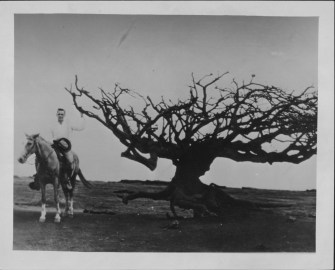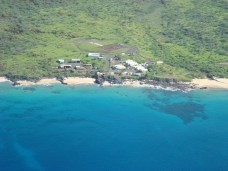These weren’t the words expected by the questioner in my response to what I thought about my first trip into the Northwestern Hawaiian Islands (now the Papahānaumokuākea Marine National Monument.)
I think she was expecting words like: spectacular, pristine, resource rich, special, abundant, etc.
Yes, it’s all those descriptors, too; and for me, therefore, “different.”
I wasn’t trying to be cute, but, rather, acknowledge the responsibility we faced in protecting this place. (I have been to the Northwestern Hawaiian Islands several times, each time reinforced the feeling.)
My first trip – a 3 ½ plane ride there, 3 ½ hours on the ground and 3 ½ hours back – was to Tern Island at French Frigate Shoals (it looks like an aircraft carrier in the reef.)
French Frigate Shoals is the largest atoll in the chain, taking the form of an 18-mile long crescent. It is estimated to be 12.3 million years old.
Tern Island (approximately 30-acres) in the atoll is the site of a Fish & Wildlife Service field station, which occupies a former U.S. Coast Guard Long-Range Aids to Navigation (LORAN) station that closed in 1979.
A relatively deep (80 to 100 feet) coral reef at this atoll has been recently discovered to function as a spawning site for Ulua (the giant trevally); a rare discovery of spawning sites for top predators.
The lagoon is also unusual in that it contains two exposed volcanic pinnacles representing the last vestiges of the high island from which the atoll was derived, as well as nine low, sandy islets.
The sand islets are small, shift position, and disappear and reappear. These islets provide important habitat for the world’s largest breeding colony of the endangered Hawaiian monk seal.
On a tour around Tern Island we saw monk seals and turtles resting on the sandy shore, as well markings in the sand of a turtle who laid her eggs the night before.
And lots of birds … mostly terns —> Tern Island.
On that trip, we were unexpectedly greeted by Jean-Michel Cousteau; he was on the island during his filming of “Voyage to Kure.”
Here’s a link to the Google ‘Street View’ on Tern Island.
I also visited Midway. Look at a map of the Pacific and you understand the reasoning for the “Midway” reference (actually, it’s a little closer to Asia than it is to the North American continent.)
Kuaiheilani, suggested as a mythical place, is the traditional name for what we refer to as Midway Atoll. Described in the legend of Aukelenuiaiku, the origin of this name can be traced to an ancient homeland of the Hawaiian people, located somewhere in central Polynesia. (Kikiloi)
According to historical sources, this island was used by Native Hawaiians even in the late-1800s as a sailing point for seasonal trips to this area of the archipelago.
The Northwestern Hawaiian Islands, and in particular Midway Atoll, became a potential commodity in the mid-19th century. The United States took formal possession of Midway Atoll in August of 1867 by Captain William Reynolds of the USS Lackawanna.
Midway’s importance grew for commercial and military planners. The first transpacific cable and station were in operation by 1903. In the 1930s, Midway became a stopover for the Pan American Airways’ flying “clippers” (seaplanes) crossing the ocean on their five-day transpacific passage.
The United States was inspired to invest in the improvement of Midway in the mid-1930s with the rise of imperial Japan. In 1938 the Army Corps of Engineers dredged the lagoon during this period and, in 1938, Midway was declared second to Pearl Harbor in terms of naval base development in the Pacific.
The construction of the naval air facility at Midway began in 1940. At that time, French Frigate Shoals was also a US naval air facility. Midway also became an important submarine advance base.
Here’s a link to the Google ‘Street View’ on Midway Atoll.
Here’s a short video of some of the albatross on Midway.
Here’s a link to the Google ‘Street View’ on Laysan Island.
Here’s a link to the Google ‘Street View’ on Lisianski Island.
Here’s a link to the Google ‘Street View’ on Pearl and Hermes Atoll.
While I was Chair at DLNR, we created the Refuge rules whose intent is “To establish a marine refuge in the Northwestern Hawaiian Islands for the long-term conservation and protection of the unique coral reef ecosystems and the related marine resources and species, to ensure their conservation and natural character for present and future generations.“ Fishing is prohibited.
This started a process where several others followed with similar protective measures. The BLNR unanimously adopted the State’s Refuge rules, President Bush declared it a Marine National Monument and UNESCO designated it a World Heritage Site.
Some ask why we imposed such stringent limitations on use in this area. For me, it ended up to be pretty simple; it is the responsibility we share to future generations, to allow them to see what it looks like at a place in the world where you don’t take something.
Check out more on the Monument (look at the Images and Videos, you’ll see this place really is different:) http://www.papahanaumokuakea.gov
Follow Peter T Young on Facebook
Follow Peter T Young on Google+
Follow Peter T Young on LinkedIn
Follow Peter T Young on Blogger






























































